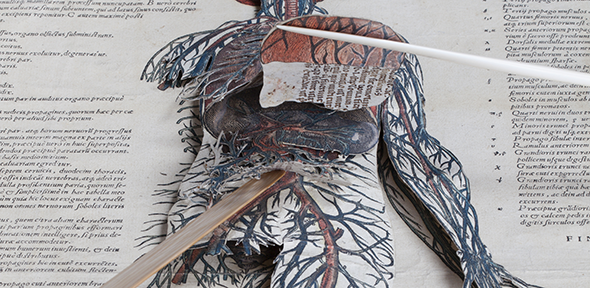
Cambridge University Library's free app celebrates ground-breaking anatomical illustrations – the world’s first pop-up book
Download Words that Changed the World on the Apple Store
Epitome is a landmark in the history of science, published almost 500 years ago. It was the first printed book to accurately depict human anatomy, and revolutionised our understanding of the human body. Cambridge University Library’s new app Words that Changed the World enables anyone to see these stunning images in eye-popping close-up detail.
The Epitome and its companion De fabrica were written by the Belgian Andreas Vesalius, one of the greatest anatomists of all time. As well as offering ground-breaking science, the books helped put dissection at the heart of anatomical and medical practice, and set new standards in book illustration.
Vesalius used extraordinarily detailed woodcuts to communicate our complex anatomy, hand-coloured in this remarkable copy. The Epitome also contains the world's first pop-up illustration – a sheet designed to be cut up and carefully glued together to make a multi-layered paper manikin. It shows in three dimensions the arrangement of the muscles, blood vessels and bones.
The book's beautiful images make a powerful case for dissection: on one page, a flayed muscle man balances a skull on one hip; on another, a skeleton leans – head in hand – on a sarcophagus bearing the inscription ‘death robbed him of all his beauty’.
Like the illuminated manuscripts that came before printed books, the text of Epitome is lavishly illustrated, but the images in the initials are disturbing as well as beautiful. They offer tips on the easiest way to prepare a skeleton – by boiling a body in a cauldron and then scraping the bones clean with a knife – while counselling against the dirty and difficult method of macerating a corpse in lime.
Using the app, you can:
- Tap the screen for pop-up captions charting the history of anatomy – from the Greek Galen to the first known record of a public dissection in England at Magdalene College, Cambridge in 1564-5.
- Zoom in on Epitome's fantastic frontispiece, and see if you can spot Galen and Hippocrates in the audience of Vesalius’s public dissection.
- Get under the skin of human anatomy – through the app's video, images, illustrations and photographs – and see the muscle, bones and blood vessels that lie beneath.
- Enjoy short films about how this innovative book changed the way that we see ourselves.
- Discover more about its extraordinary creator, Andreas Vesalius, the man who revived the art and science of anatomy.
- See Vesalius’s astrological chart – hand-drawn by Milanese doctor Girolamo Cardano.
- Take a peek at a pocket-sized skeleton – a boxwood figure and ivory skeleton given to the University Library in 1591 by London surgeon John Banister.
